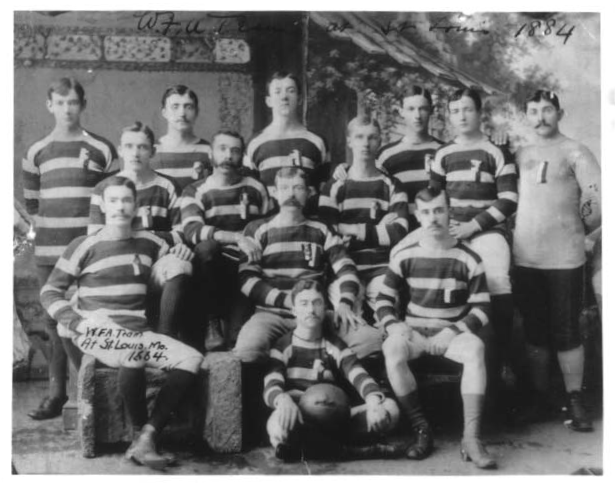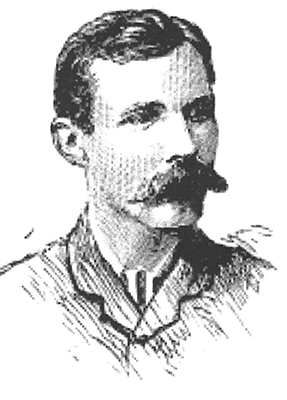
Careful readers of Sunday’s Dec. 14, 1884, edition of the St. Louis Globe-Democrat noticed a four-line item at the end of a brief “Foot Ball” report on page 9:
“The Thistles Club have, through hard work, prevailed upon a Canadian team, which will represent the best-playing talent in Canada, to visit St. Louis. The first match with the Canadians will be played on Christmas Day.”
The rather casual reference to the upcoming game carried significance only realized many years later: The match would be the first known international soccer game played in the United States, and, perhaps, anywhere outside of England.
The Canadians scheduled three games in St. Louis on Dec. 25, 27 and 28. Bad weather forced the cancellation of the second game. The Canadians demolished the Thistles, 9-0, on Christmas Day and defeated a team formed from the Thistles and another local club, the Hibernians, 5-3 on Dec. 28.
It’s not known how the Thistles “prevailed upon” the Canadians to visit, but the lead-up to the games is as interesting as the games themselves.
The last few months of 1884 saw important milestones in the development of soccer in St. Louis, where the earliest mention of a scheduled “foot ball” game appeared in a St. Louis newspaper in February 1872. May 1875 saw the first report of a soccer-like game that was actually played in St. Louis. Thereafter, soccer games in St. Louis were one-off affairs resulting from one team challenging another to a game, or as part of a festival of outdoor events such as the 1877 St. Louis Exposition, where a soccer-like game was played that September.
Those practices began to change in late 1884.
By the mid–1880s, there were five major soccer teams in St. Louis: the Irish-American Hibernians and Shamrocks, the Scottish-American Thistles, the St. Louis Football Club and the German-American Westerns. Organized competition involving these teams began replacing one-off games. In the autumn of 1884, the Lafayette Brewery offered a gold cup to the winner of a Hibernians-Thistles match. After two ties, the Hibernians finally prevailed in a third game on November 9.
More importantly, not just for St. Louis but perhaps for the global history of the sport, the Hibernians, Thistles, Westerns and a fourth club, the Jacksons, established the city’s first soccer “league” on October 28, 1884, using “association football,” or soccer, rules rather than rugby rules. “If this was truly a football ‘league,’ it predated the first in England by more than two years,” David Wangerin wrote in his book, Distant Corners.
It was sometime during the autumn of 1884 that the Thistles invited the Canadians to spend the Christmas holidays playing soccer in St. Louis. Founded by Scottish-American St. Louisans on Oct. 10, 1883, the blue-and-white-clad Thistles were grounded in a Scottish heritage that likely played a major role in connecting with like-minded Scottish-American players and promoters in Canada, such as David Forsyth.

Any discussion of soccer in Canada begins with David Forsyth. “The Father of Canadian Soccer” arrived in Canada less than a year after his birth in Scotland in 1852. “Forsyth not only initiated every significant soccer happening in the first 20 years or so of soccer’s birth in Canada, he participated in most of those milestone events,” Les Jones wrote in 2013’s Soccer: Canada’s National Sport.
Forsyth settled in today’s Kitchener, Ontario, when the town was named Berlin. A soccer lover dating from his playing days at the University of Toronto in the mid-1870s, Forsyth spurred soccer’s growth in the Berlin area while teaching at Berlin High School. By 1884, he had introduced soccer at the school, formed a local club that became known as the Berlin Rangers, and was the first secretary-treasurer of Canada’s Western Football Association (WFA). A team representing the WFA, and including the 32-year-old Forsyth, made the trip to St. Louis for the history-making matches during the Christmas holidays.
The Canadians played according to the soccer rules of the Scottish Football Association (SFA), according to Ed Farnsworth, Tom McCabe and Kurt Rausch in a story posted on the website of the Society for American Soccer History in March 2022. The SFA rules varied somewhat from the more widely recognized laws of the game issued in England in December 1863. St. Louis newspapers did not specify if St. Louis teams followed Scottish or English rules.
Unlike other St. Louis newspapers, which, if at all, barely mentioned the St. Louis vs. WFA games, the St. Louis Globe-Democrat covered them before and after (but, as was the practice for those days’ soccer coverage, failed to identify any of the goal-scorers in either match). “The Canadians were picked from the strongest teams in the Dominion and each member is said to be a fine athlete,” the Globe reported in its Dec. 25 preview of that day’s match with the Thistles of St. Louis at Union Park, Jefferson and Cass Avenues. The account included each team’s starting 11.
The WFA starters included Forsyth. The Globe gave few details of the first game on Dec. 25, which ended in a decisive 9-0 win for the Canadians over the Thistles. But a detailed report of the final match on Dec. 28 noted that as the team’s captain, Forsyth was clearly in charge of the WFA team. He “raced about giving numerous commands, but doing but little kicking,” the Globe wrote in its Dec. 29 edition.
The bad weather that canceled the scheduled second game on Dec. 27 threatened to do the same on Dec. 28. But organizers salvaged the last game by moving it from unplayable Union Park to better conditions at Sportsman’s Park at Grand and Dodier. Playing in the rain before about 500 spectators, the Canadians and a local team made up of Thistles and Hibernians put on a highly praised exhibition.
“Notwithstanding the wet and slippery ground and drenching the players were subjected to, the contest was the best football event that ever took place in St. Louis,” the Globe reported. The newspaper praised the Canadians (a “model team,” according to the story) for playing their positions and for the timely commands issued by Forsyth that kept the visitors on the attack. Whenever the St. Louis players concentrated on stopping a Canadian who had the ball, “Capt. Forsyth would at once order the ball passed from the point of attack to another where one of his men had but little or no opposition.”
The victorious Canadians had kindly words for the two St. Louis teams they defeated, and Forsyth offered a prediction. According to the Globe, Forsyth “says football is called ‘the noxious Scotch weed,’ but is bound to grow wherever it gets a hold, and it surely will become popular in the United States.” Forsyth’s prediction took more than a century for soccer to gain traction in the USA. But the “weed” grew quickly in St. Louis, the home to generations of world-class players right to the present day.
As for international soccer in St. Louis, 16 years would pass before foreign teams — also from Ontario — returned. One was the Berlin Rangers, founded by Forsyth two decades earlier. This time, the Canadians found “the noxious weed” somewhat tougher pickings than in 1884. After an easy 8-0 win over a team of players combined from the St. Louis Globes and Shamrocks, the Rangers ended their two-game trip on Dec. 30 with a 5-2 loss to Christian Brothers College.
A version of this article previously appeared at soccermadeinstlouis.com.
